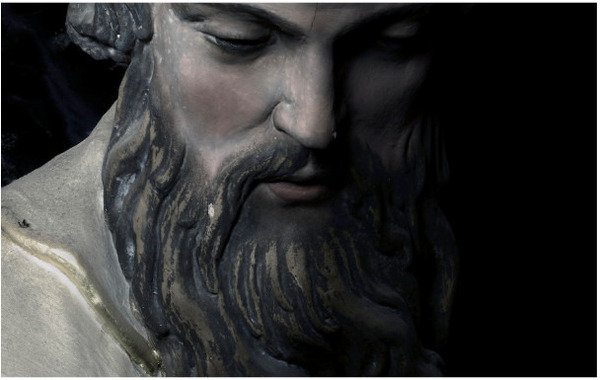19/4/2014
Glorious Bodies
IKOB, Eupen
An overall installation by Sophie Langohr (*1974) and Jacques Charlier (*1939); two generations meeting and communicating with each other, two perspectives of the holiness, yesterday and nowadays...

The ikob celebrates Easter... with an overall installation
–
Sophie Langohr (*1974) and Jacques Charlier (*1939); two generations meeting
and communicating with each other, two perspectives of the holiness, yesterday
and nowadays...
“But for the present age, which prefers the sign of the thing signified, the copy to the original, representation to reality, appearance to
essence... truth it considered profane and only illusion is sacred. Sacredness is in fact held to be
enhanced in proportion as truth decreases and
illusion increases, so that the highest degree of illusion come to be the highest degree of sacredness.”
Feuerbach, Preface to the second edition
of The Essence of Christinanity quoted by Guy Debord in The Soc
iety of the Spectacle
“From the stock of a museum, Sophie Langohr unearthed fifteen statues of the Vir
gin Mary in the Saint
-
Sulpice style, which today represent the purest form of
religious knick
-
knack and the beginnings of a semi
-
industrial art. The artist confronts the outmoded faces with the ones found on the internet of the current muses
that incarnate
the big brands of the luxury industry.
As diptychs, these transfigurations give us the consummate illusion of a particularly dreaded cinema
-
photo
-
digital aesthetics. Pushing the desecration even further,
Langohr uses the tricks of the shooting and fashion photography to impose all the glory and
the celebrity of the current models and stars on the saints, which were
sculpted in 1640 by Jérémie Geisselbrunn and intended for the Church of the Friar Minors in Cologne. Today they stand on the pillars of the Saint
-
Nicholas church in
Eupen. These are t
he icons of the Fathers and the Apostles
–
frozen in this unexpected second (of) eternity. The casting is truly singular.
Jacques Charlier has also been exploring the fake ideal of the transubstantiation for quite some time, observing the theologies of a
rt and the objet d’art which is seen
as redeeming. The latter is appropriated by the market which, as the artist says, is capable of transforming the slightest draft into a transfigured object, under the
strategic gaze of a global curie. [...]
From Leda to
the twins of the Doublure du Monde, from Saint Rita, the patron of lost and impossible causes
–
of which art wouldn’t be the least
–
to Melusine or
Morgan, art is a disenchanted physical reflection, the sign that the present could be followed by the past,
an anguish that is generated by melancholy. The image of
Saint Rita, the turmoil, much more than that of Marilyn or Tina Turner, he argues. As a last resort facing a society in disarray, Sergio Bonati adds, it is this Saint
-
Sulpice inspired image that Jac
ques Charlier often ironically evokes, referring to an increasingly instrumentalized art market and history. Coming back to certain forms
of devotion, could art thus be a sort of ex
-
voto?”
(Excerpts of a text by Jean
-
Michel Botquin, Galerie Nadja Vilenne,
Liège)
* Thanks to the outstanding support of the Province de Liège, new works of both artists and a catalog are produced on the occasion.
Image: Sophie Langohr
,
Hl.
Matthias
durch
Gérémie Geisselbrunn (1595
–
1660),
aufbewahrt in der St. Nikolaus Pfarrkirche, Eupen, fotografier wie Dimitris
Alexandrou durch
Errikos Andreou.
Aus der Serie
Glorious Bodies
, 2014.
©
Sophie Langohr
Press contact:
Ingrid Mossoux Phone: +32 87560110 i.mossoux@ikob.be
Opening 20th of april, 2014 at 3 p.m.
Ikob - Museum for contemporary art
Rotenberg 12 B 4700 Eupen, Belgium
Opening hours:
Tuesday–Sunday, 13.00–17.00
closed on monday
Every first Wednesday of the month: 1–7 pm., Free



